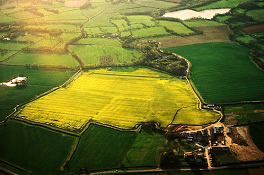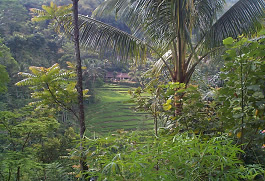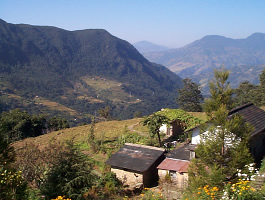
Environmental concerns are becoming increasingly important as the global human population increases along with its consumption of natural resources. There is a pressing need to manage these resources wisely so that the needs of the current generation can be met without compromising the ability of future generations to meet their needs.
Many problems relating to the management of natural resources require understanding of the complex ways that social, economic and biophysical processes interact with one another. Focusing only on a single factor has often been inadequate in addressing many of these problems. However, the complexity of these interactions means that tools have to be developed to help us understand how they work.
The People and Landscape Model (PALM) is one such tool. PALM is a spatially-explicit agent-based model operating at the landscape level, and contains a number of decision-making entities (e.g. farm households) located on a landscape made up of a number of heterogeneous land units, each of which contains routines to simulate its water balance and carbon and nitrogen dynamics (including GHG emissions) over time. Decisions made by the household agents result in actions which may influence the fluxes of water, carbon and nitrogen within the landscape.

Applications of the model
An initial application of the model was to investigate the sustainability of maize-millet cropping systems in the mid-hills of Nepal (Matthews & Pilbeam, 2005).
In more recent work, PALM has been used to evaluate economic instruments such as taxes (‘sticks’) or incentives (‘carrots’) aimed at reducing GHG emissions and the impact that this may have on farmer livelihoods (Matthews & Bakam, 2007).
Current work is aimed at evaluating some of the challenges facing the implementation of such schemes, including the setting of appropriate thresholds of GHG emissions, transaction costs, and measuring and monitoring of individual and aggregate behaviour of land managers.
Other work is using the soil and vegetation components to estimate carbon sequestration rates under bioenergy crops.
Current projects

Publications
- Matthews, R., Gilbert, N., Roach, A., Polhill, G. & Gotts, N., 2007. Agent-based land-use models: a review of applications. Landscape Ecology 22(10):1447-1459.
- Matthews, R.B., 2007. Modelling the sustainability of rural systems: concepts, approaches, and tools. Journal of Agricultural Science 145:(in press).
- Matthews, R.B. & Bakam, I., 2007. A combined agent-based and biophysical modelling approach to address GHG mitigation policy issues. In: D. Kulasiri & L. Oxley (Editors), Proceedings of MODSIM 2007 International Congress on Modelling and Simulation, Dec 10-13, 2007. Modelling and Simulation Society of Australia and New Zealand, Christchurch, New Zealand.
- Matthews, R.B., 2006. The People and Landscape Model (PALM): towards full integration of human decision-making and biophysical simulation models. Ecol. Modelling 194(4):329-343.
- Matthews, R. & Selman, P., 2006. Landscape as a focus for integrating human and environmental processes. Journal of Agricultural Economics 57(2):199–212.
- Matthews, R.B. & Pilbeam, C.J., 2005. Modelling the long-term sustainability of maize/millet cropping systems in the mid-hills of Nepal. Agriculture, Ecosystems & Environment 111(1-4):119-139.
- Matthews, R.B. & Pilbeam, C.J., 2005. Modelling the long-term productivity and soil fertility of maize/millet cropping systems in the mid-hills of Nepal. In: A. Zerger & R.M. Argent (Editors), Proceedings of MODSIM 2005 International Congress on Modelling and Simulation, Dec 9-12, 2005. Modelling and Simulation Society of Australia and New Zealand, Melbourne, Australia, pp. 2130-2137.
- Matthews, R.B., Polhill, J.G., Gilbert, N. & Roach, A., 2005. Integrating agent-based social models and biophysical models. In: A. Zerger & R.M. Argent (Editors), Proceedings of MODSIM 2005 International Congress on Modelling and Simulation, Dec 9-12, 2005. Modelling and Simulation Society of Australia and New Zealand, Melbourne, Australia, pp. 1617-1623.
- Matthews, R.B., 2002. Where to now with crop modelling? In: R.B. Matthews & W. Stephens (Editors), Crop-Soil Simulation Models: Applications in Developing Countries. CAB International, Wallingford, UK, pp. 209-230 (Chapter 15).
|
Updated: 23 Jan 2024, Content by: RM
|
